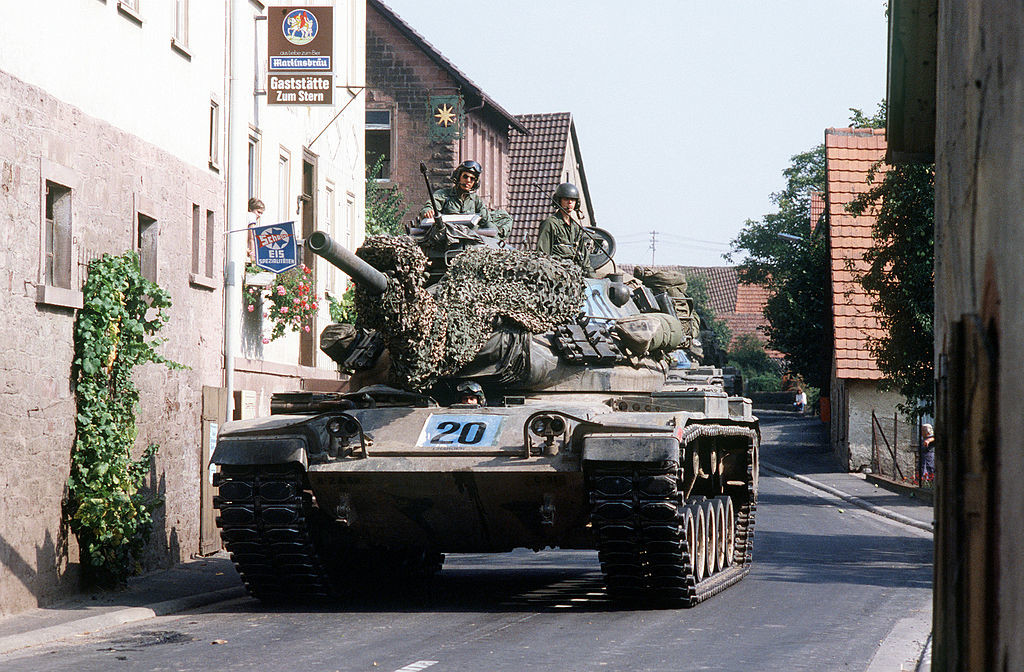(W)Archives: Prepositioning Combat Equipment in Europe? Been There, Done That

According to media reports, the U.S. military intends to preposition in Eastern Europe the military equipment necessary to support the equivalent of an Army brigade, some 3,000–5,000 troops. A company’s worth of equipment is to be stored in each of the Baltic States and a battalion’s worth of equipment would be stored in each of three other countries: Poland, Romania and Bulgaria. (Hungary may receive a battalion’s worth of equipment, as well.) Now Army personnel can be flown into Europe for training and fall onto the prepositioned equipment, thereby saving the expense and time of shipping heavy equipment back and forth from the United States. Of course, the Pentagon is aware that the equipment might also be useful in times of crisis or war involving Russia and that is almost certainly the primary motive for this initiative.
The United States Army has stored unit sets of equipment on the front lines of Europe in the past. During the Cold War this was done at POMCUS sites, where POMCUS stood for “Prepositioned Organizational Materiel Configured to Unit Sets.” The unofficial U.S. Army in Germany website has a wonderful collection of photographs, transcribed period documents, and information about this little-remembered program that is well worth exploring.
The POMCUS program started in 1961. The Joint Chiefs were concerned that the Soviet Union could mobilize and move forces to East Germany faster than the U.S. Army in Europe could mobilize units and move them across the Atlantic to West Germany. Accordingly, they ordered the U.S. Army in Europe to store the equipment for an armored division, an infantry division and ten support units in West Germany. The equipment was stored at seven sites in West Germany: Mannheim, Karlsruhe, Kaiserslautern, Pirmasens, Germersheim, Idar-Oberstein, and Worms. The U.S. Army in Germany collection of photographs of Pirmasens gives a good sense of what these sites looked like, especially in the early days.
Over time the POMCUS program grew substantially in scope and sophistication. By the end of the 1970s it comprised equipment for three divisions, an armored cavalry regiment, logistical and medical units, and 84 additional non-divisional support units. Later another division set was added. (Few of these sets were ever complete, mind you.) During the Reagan Administration, consideration was given to expanding POMCUS even further. Overseeing this enormous amount of equipment was the Combat Equipment Group, Europe (CEGE) of the 21st Support Command, which eventually numbered more than 4,100 personnel spread across 18 storage sites in four countries. The 21st Support Command’s command briefing from the early 1980s stated that:
We use four types of storage for POMCUS equipment. Conventional warehouses are provided at all POMCUS sites primarily to store non-mechanized equipment. Open storage is used primarily for trailers and other equipment unable to be stored in currently available warehouse space. The best type of storage is controlled humidity. This is accomplished by warehouses and stress tension structures. We have 117 of these (humidity controlled) warehouses in the Command: 113 in the Federal Republic of Germany and 4 in Belgium. Inside this type of warehouse (humidity controlled), we store door-to-door, wall-to-wall, and bumper-to-bumper with only 18” access aisles between equipment.
When the Cold War ended, the POMCUS sites seemed unnecessary and the program was drawn down, though equipment for a few brigades has remained positioned in Western Europe, alongside a few active combat units.
Today, the positioning of a brigade’s worth of equipment spread across six or seven countries seems threatening to Moscow. A Russian Defense Ministry spokesman complained that that placement of American military equipment “would mark the Pentagon and NATO’s most aggressive step since the Cold War.” He announced that Russia would match any such buildup and might deploy nuclear weapons to the Kaliningrad Oblast, adjacent to Poland and Lithuania.
The stiff response from Moscow to the modest American move is remarkable when one considers that during the Cold War the United States had much larger equipment sets prepositioned in West Germany, then the front-line in the confrontation with Moscow.
Perhaps we should be encouraged that the strategic situation in Europe has come so far that a very small (and inexpensive) deployment to the continent seems to offer major benefits. On the other hand, the fact that the move of a mere brigade-sized equipment set can produce such a response from Moscow is alarming, a sign of the fragility that Vladimir Putin has introduced into the European security system.
Mark Stout is a Senior Editor at War on the Rocks. He is the Director of the MA Program in Global Security Studies and the Graduate Certificate Program in Intelligence at Johns Hopkins University’s School of Arts and Sciences in Washington, D.C.
